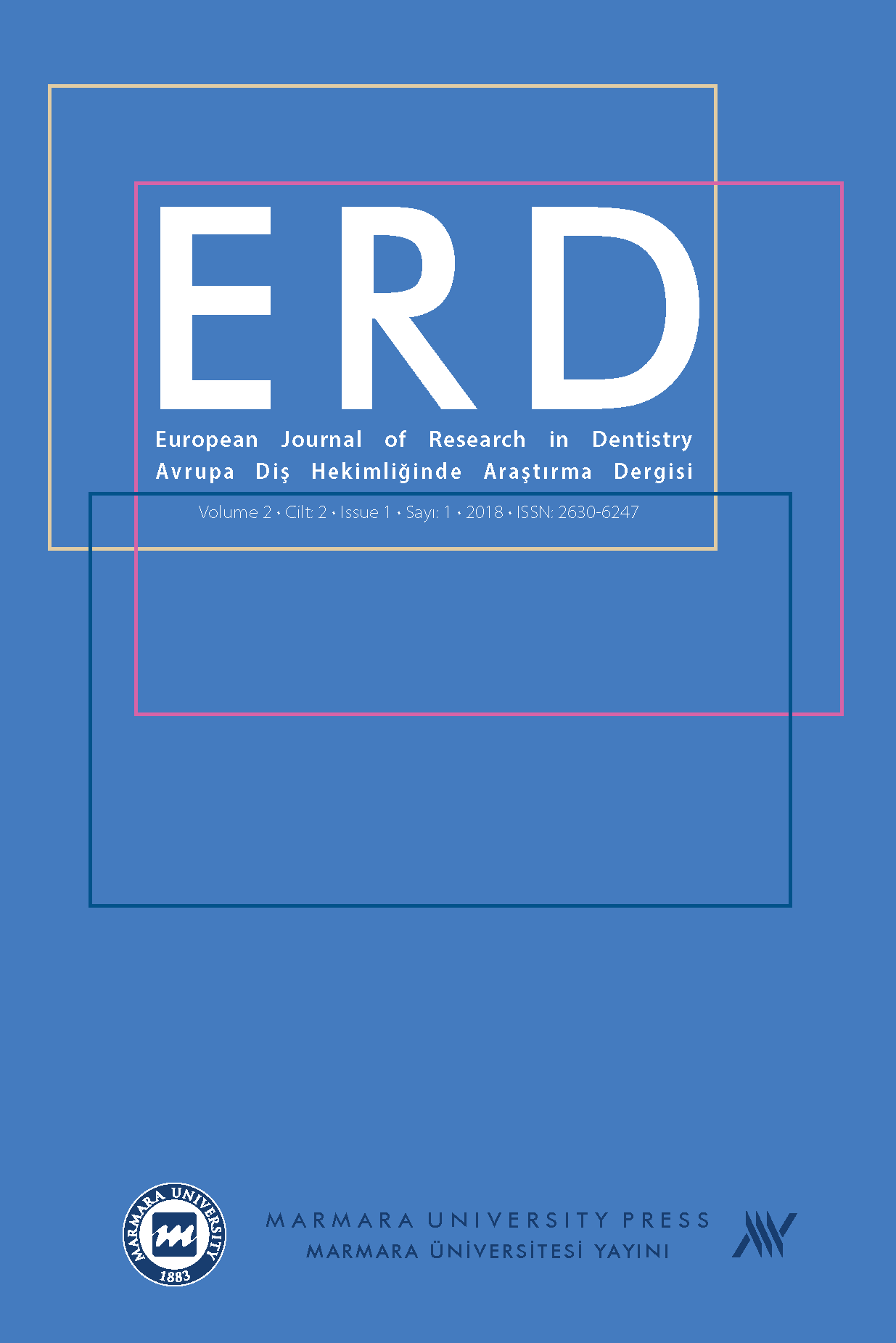Maksilla Anterior Bölgede Karbon Fiber Takviyeli Poli-Eter-Eter-Keton İmplantların Çevre Kemikte Oluşturduğu Streslerin Sonlu Elemanlar Analizi ile İncelenmesi
Cfr-Peek dental implant, anterior maksilla, Sonlu elemanlar analizi
İnvestigation of Stress Levels At Surrounding Bone of Carbon Fiber Reinforced Polyether-Ether-Keton Implants in The Maxilla Anterior Region with Finite Elemental Analysis
___
- 1. Brånemark P. I., Breine U., Adell R., et al. Intra-osseous anchorage of dental prostheses: I. Experimental studies. Scand. J. Plast. Reconstr. Surg. Hand Surg. 3, 81–100 ,1969.
- 2. Shapira Lior, Klinger Avigdor, Tadir Anat, et al. Effect of a niobium-containing titanium alloy on osteoblast behavior in culture. Clin. Oral Implants Res. 20, 578–582 ,2009.
- 3. Velasco-Ortega Eugenio, Jos Angeles, Cameán Ana M., et al. In vitro evaluation of cytotoxicity and genotoxicity of a commercial titanium alloy for dental implantology. Mutat. Res. - Genet. Toxicol. Environ. Mutagen. 702, 17–23 ,2010.
- 4. Egusa Hiroshi, Ko Nagakazu, Shimazu Tsunetoshi, et al. Suspected association of an allergic reaction with titanium dental implants: A clinical report. J. Prosthet. Dent. 100,344-347,2008.
- 5. Müller Kurt, Valentine-Thon Elizabeth. Hypersensitivity to titanium: clinical and laboratory evidence. Neuro Endocrinol. Lett.27,31-35 ,2006.
- 6. Huiskes R, Weinans H, van Rietbergen B. The relationship between stress shielding and bone resorption around total hip stems and the effects of flexible materials. Clin. Orthop. Relat. Res.274,124-134 ,1992.
- 7. Yildirim Murat, Fischer Horst, Marx Rudolf, et al. In vivo fracture resistance of implant-supported all-ceramic restorations. J. Prosthet. Dent. 90, 325–331 ,2003.
- 8. Andreiotelli Marina, Wenz Hans J., Kohal Ralf Joachim. Are ceramic implants a viable alternative to titanium implants? A systematic literature review. Clinical Oral Implants Research 20, 32–47 ,2009.
- 9. Özkurt Zeynep, Kazazoğlu Ender. Zirconia Dental Implants: A Literature Review. J. Oral Implantol. 37, 367–376 ,2010.
- 10. Özkurt Zeynep, Kazazoĝlu Ender. Clinical success of zirconia in dental applications. J. Prosthodont. 19, 64–68 ,2010.
- 11. Schwitalla Andreas, Müller Wolf-Dieter. PEEK Dental Implants: A Review of the Literature. J. Oral Implantol. 39, 743–749 ,2011.
- 12. Goodacre C J, Kan J Y, Rungcharassaeng K. Clinical complications of osseointegrated implants. J. Prosthet. Dent. 81, 537–52 ,1999.
- 13. RW. Treharne. Review of Wolff’s law and its proposed means of operation. Orthop Rev. 10, 35–47 ,1981.
- 14. Wiskott H. W. Anselm, Belser Urs C. Lack of integration of smooth titanium surfaces: a working hypothesis based on strains generated in the surrounding bone. Clin. Oral Implants Res. 10, 429–444 ,2003.
- 15. van Staden R. C., Guan H., Loo Y. C. Application of the finite element method in dental implant research. Computer Methods in Biomechanics and Biomedical Engineering 9, 257–270 ,2006.
- 16. Geng J. P., Ma Q. S., Xu W., et al. Finite element analysis of four thread-form configurations in a stepped screw implant. J. Oral Rehabil. 31, 233–239 ,2004.
- 17. Sevimay M., Turhan F., Kiliçarslan M. A., et al. Three-dimensional finite element analysis of the effect of different bone quality on stress distribution in an implant-supported crown. J. Prosthet. Dent. 93, 227–234 ,2005.
- 18. Meyer Ulrich, Vollmer Dirk, Runte Christoph, et al. Bone loading pattern around implants in average and atrophic edentulous maxillae: A finite-element analysis. J. Cranio-Maxillofacial Surg. 29, 100–105 ,2001.
- 19. Koca Omer Lutfi, Eskitascioglu Gurcan, Usumez Aslihan. Three-dimensional finite-element analysis of functional stresses in different bone locations produced by implants placed in the maxillary posterior region of the sinus floor. J. Prosthet. Dent. 93, 38–44 ,2005.
- 20. Zampelis Antonios, Rangert Bo, Heijl Lars. Tilting of splinted implants for improved prosthodontic support: A two-dimensional finite element analysis. J. Prosthet. Dent. 97, 535–543 ,2007.
- 21. Kurtz Steven M., Devine John N. PEEK biomaterials in trauma, orthopedic, and spinal implants. Biomaterials 28, 4845–4869 ,2007.
- 22. Toth Jeffrey M., Wang Mei, Estes Bradley T., et al. Polyetheretherketone as a biomaterial for spinal applications. Biomaterials 27, 324–334 ,2006.
- 23. Brantigan John W., Neidre Arvo, Toohey John S. The Lumbar I/F Cage for posterior lumbar interbody fusion with the Variable Screw Placement System: 10-year results of a Food and Drug Administration clinical trial. Spine J. 4, 681–688 ,2004.
- 24. Akhavan Sam, Matthiesen Mary M., Schulte Leah, et al. Clinical and histologic results related to a low-modulus composite total hip replacement stem. J. Bone Jt. Surg. - Ser. A 88, 1308–1314 ,2006.
- 25. Isidor Flemming. Influence of forces on peri-implant bone. Clin. Oral Implants Res. 17, 8–18 ,2006.
- 26. Misch Carl E., Suzuki Jon B., Misch-Dietsh Francine M., et al. A positive correlation between occlusal trauma and peri-implant bone loss: Literature support. Implant Dent. 14, 108–116 ,2005.
- 27. Albrektsson T, Zarb G, Worthington P, et al. The long-term efficacy of currently used dental implants: a review and proposed criteria of success. Int. J. Oral Maxillofac. Implants 1, 11–25 ,1986.
- 28. Şahin Saime, Çehreli Murat C., Yalçin Emine. The influence of functional forces on the biomechanics of implant-supported prostheses - A review. Journal of Dentistry 30, 271–282 ,2002.
- 29. Geng Jian Ping A., Tan Keson B.C., Liu Gui Rong. Application of finite element analysis in implant dentistry: A review of the literature. Journal of Prosthetic Dentistry 85, 585–598 ,2001.
- 30. Sato Y., Teixeira E. R., Tsuga K., et al. The effectiveness of a new algorithm on a three-dimensional finite element model construction of bone trabeculae in implant biomechanics. J. Oral Rehabil. 26, 640–643 ,1999.
- Başlangıç: 2015
- Yayıncı: Marmara Üniversitesi
Siavash ABBASGHOLİZADEH, Ferit BAYRAM, Gökhan GEDİKLİ, Can ILGIN, Yaşar ÖZKAN
Kronik Periodontitis ile Agresif Periodontitisin Farklılıkları
Hatice Selin YILDIRIM, Nimet Gül GÖRGÜLÜ, Kübra KUNDAK, Leyla KURU
Sıdıka AKDENİZ, Engin EDİBOĞLU
Ayşe KARADAYI, Fatıma BAŞTÜRK, Dilek TÜRKAYDIN, Selin GÖKER KAMALI, Tülay BAKIRCI, Hesna SAZAK ÖVEÇOĞLU
Ahmet ALTAN, Aras ERDİL, Nihat AKBULUT
Tülay BAKIRCI, Selin GÖKER KAMALI, Ömer Birkan AĞRALI, Dilek TÜRKAYDIN, Fatıma BAŞTÜRK, Ayşe KARADAYI, Hesna SAZAK ÖVEÇOĞLU
Alaa ALSAFADİ, Juan Luis COBO, İvan MENÉNDEZ-DÍAZ, Juan David MURİEL, Teresa COBO
İmplant Destekli Protetik Restorasyonlarda Kullanılan Ölçü Yöntemleri ve Materyalleri: Derleme
Elcin Keskin Özyer, Erkut Kahramanoğlu, Yılmaz Umut Aslan, Yasemin Özkan
